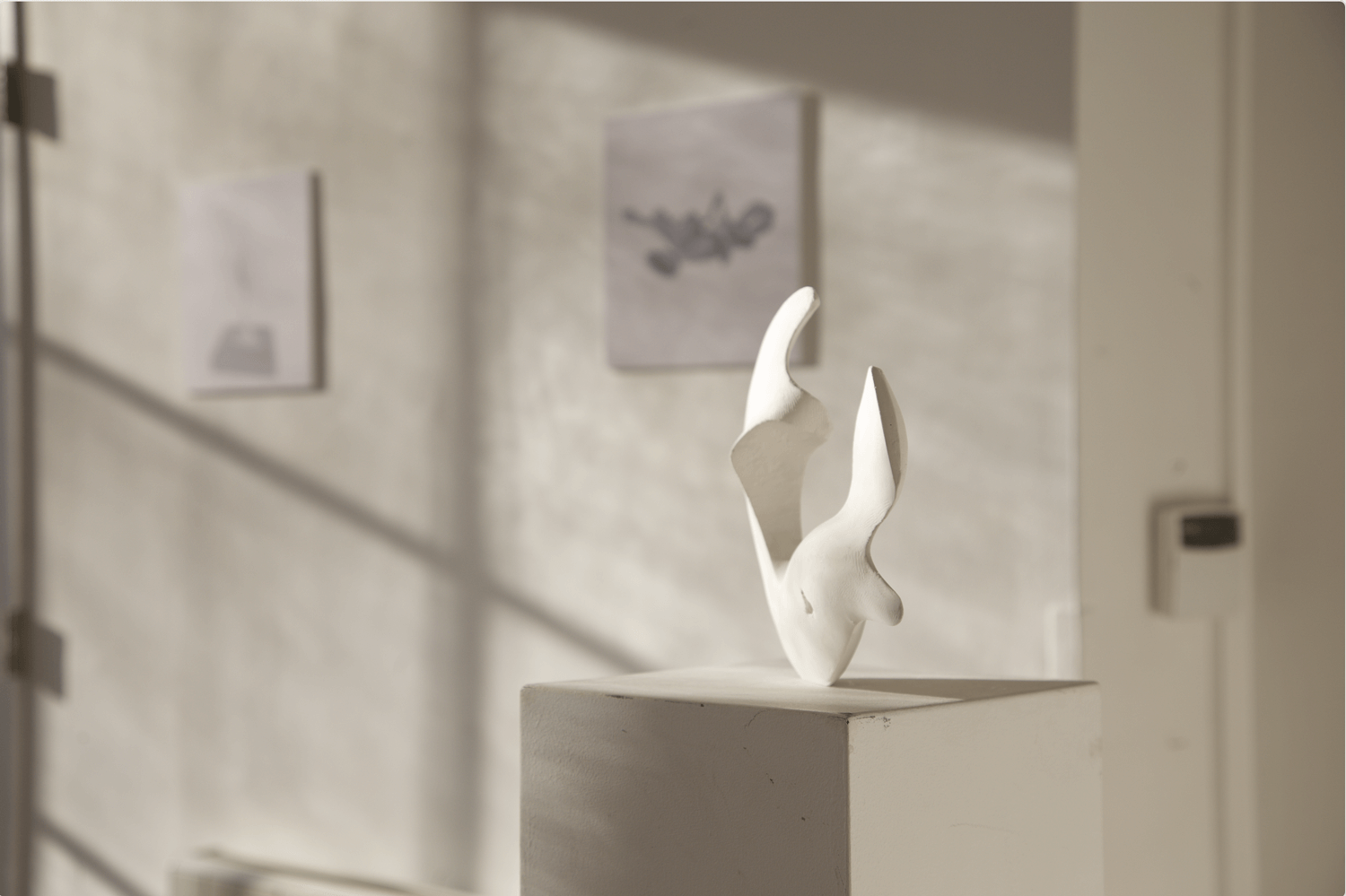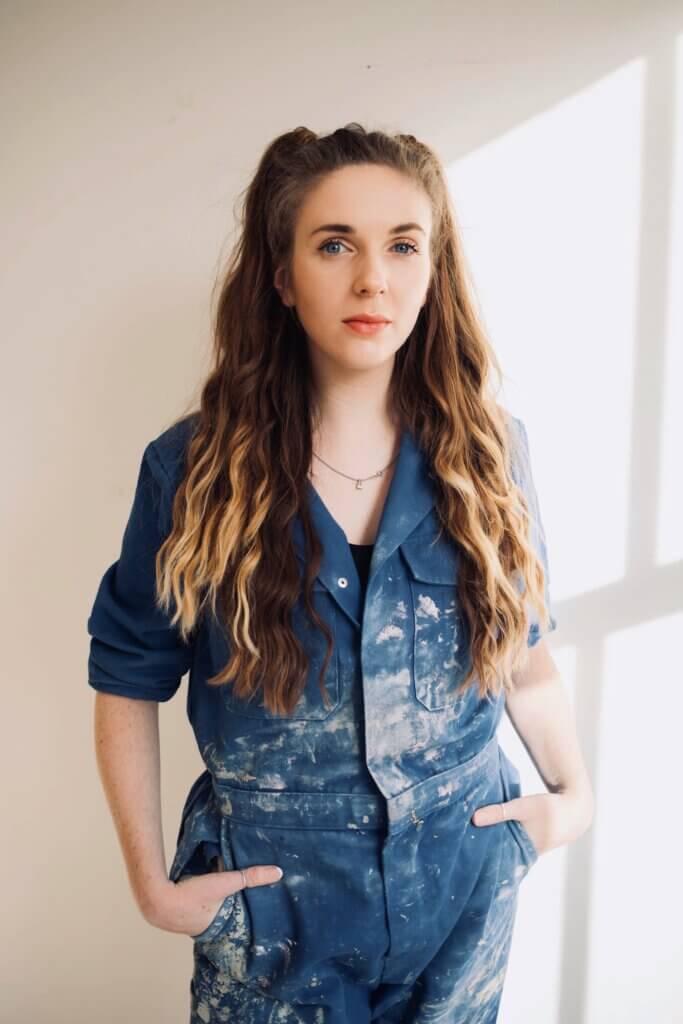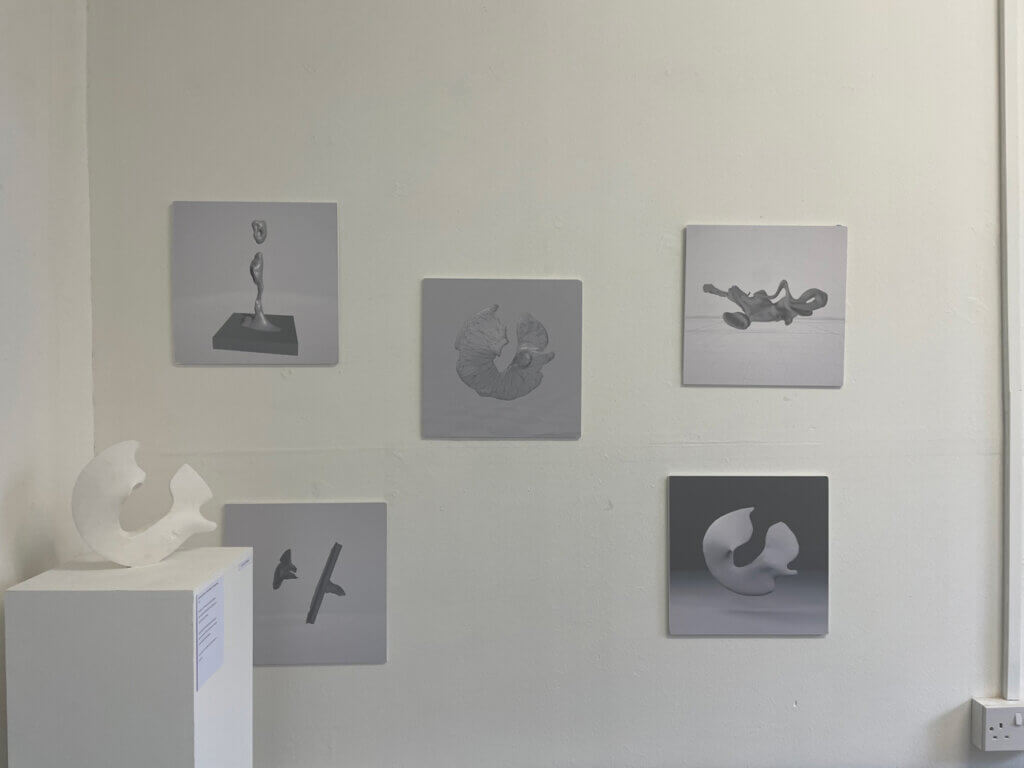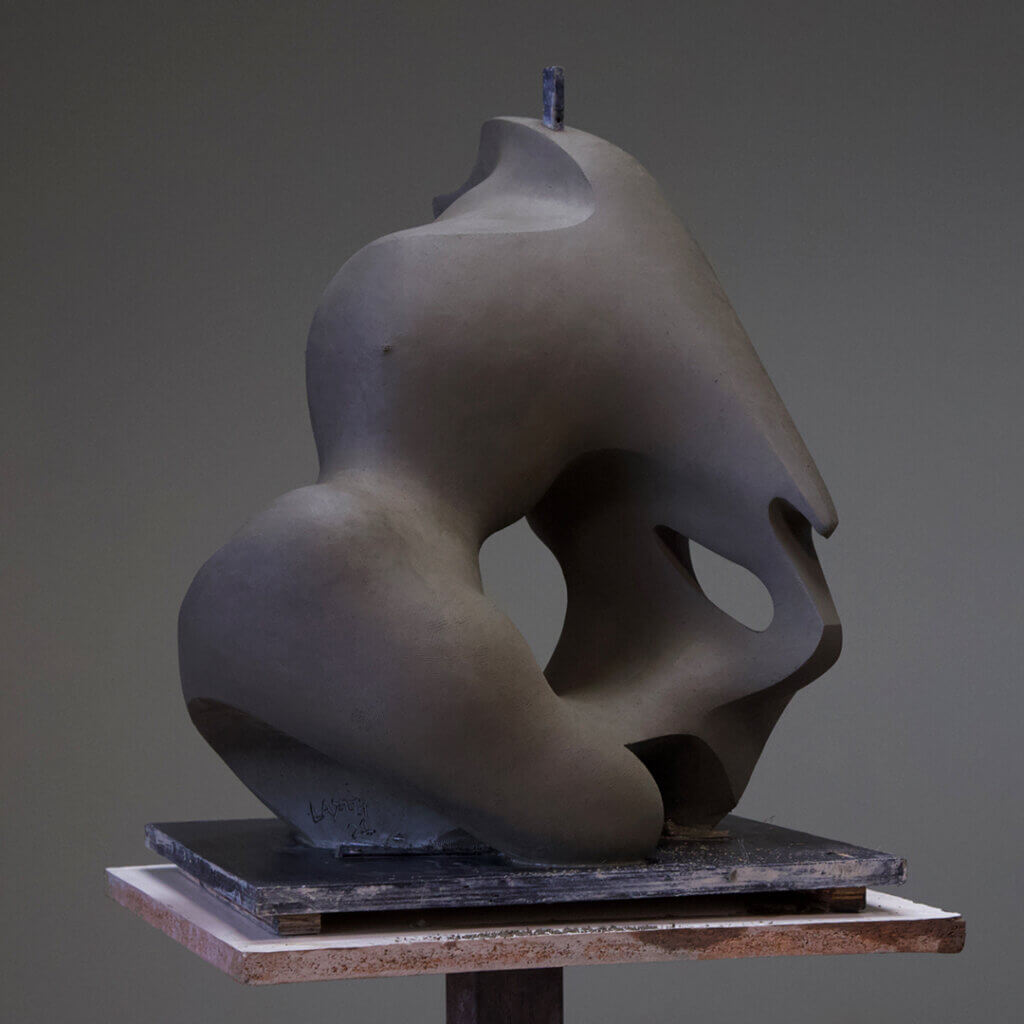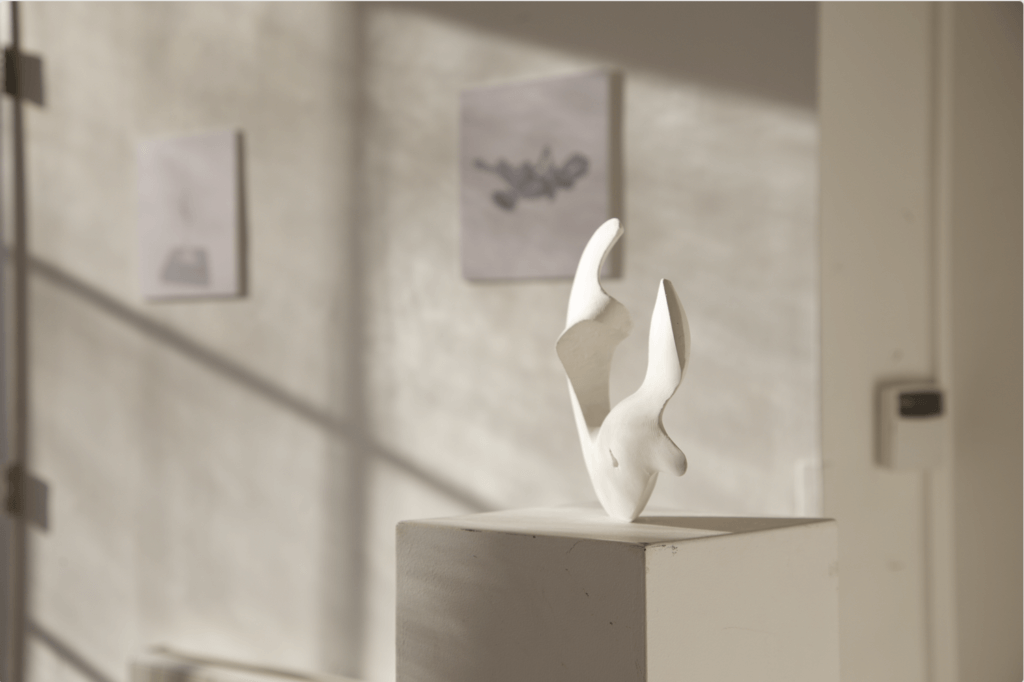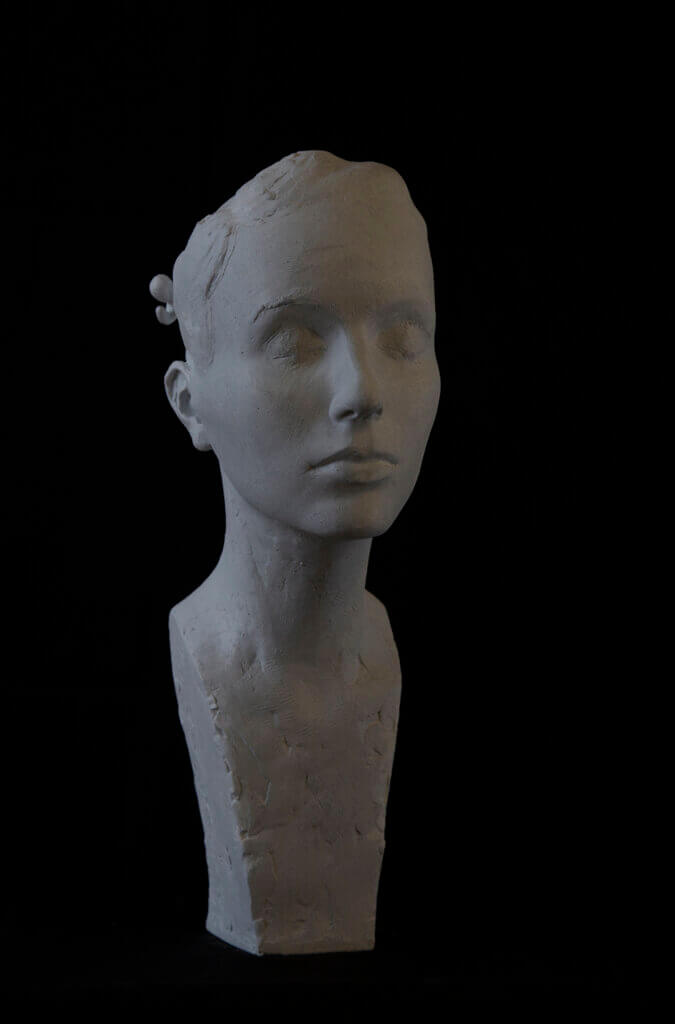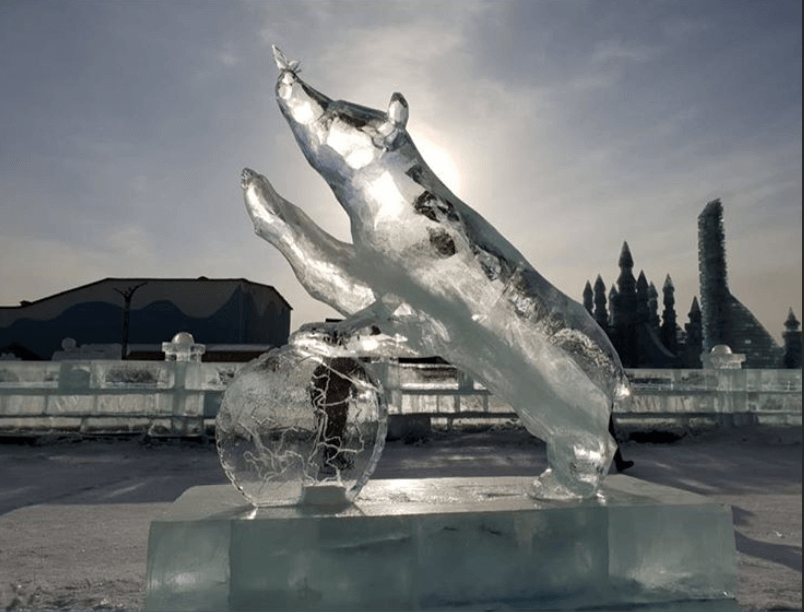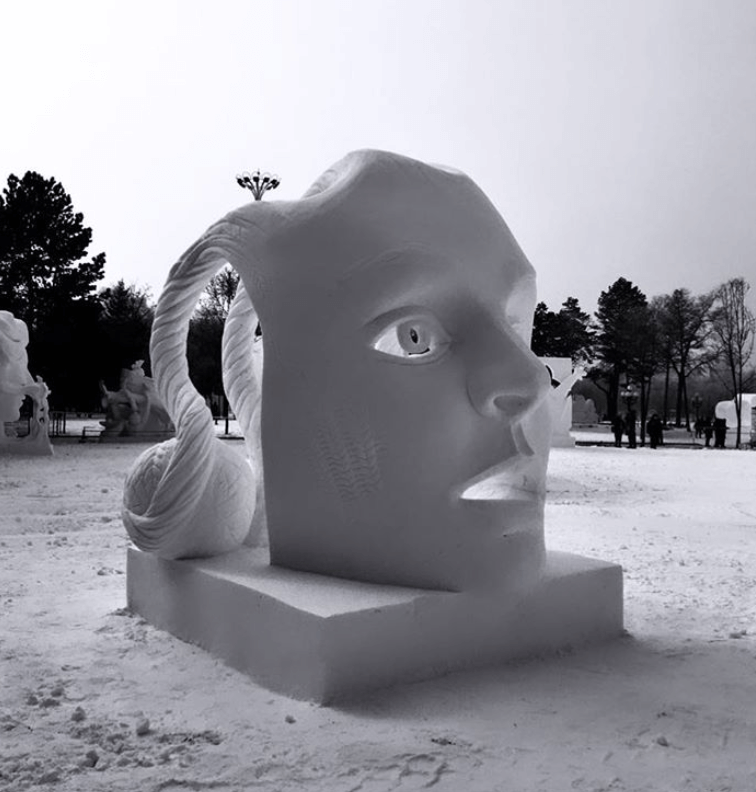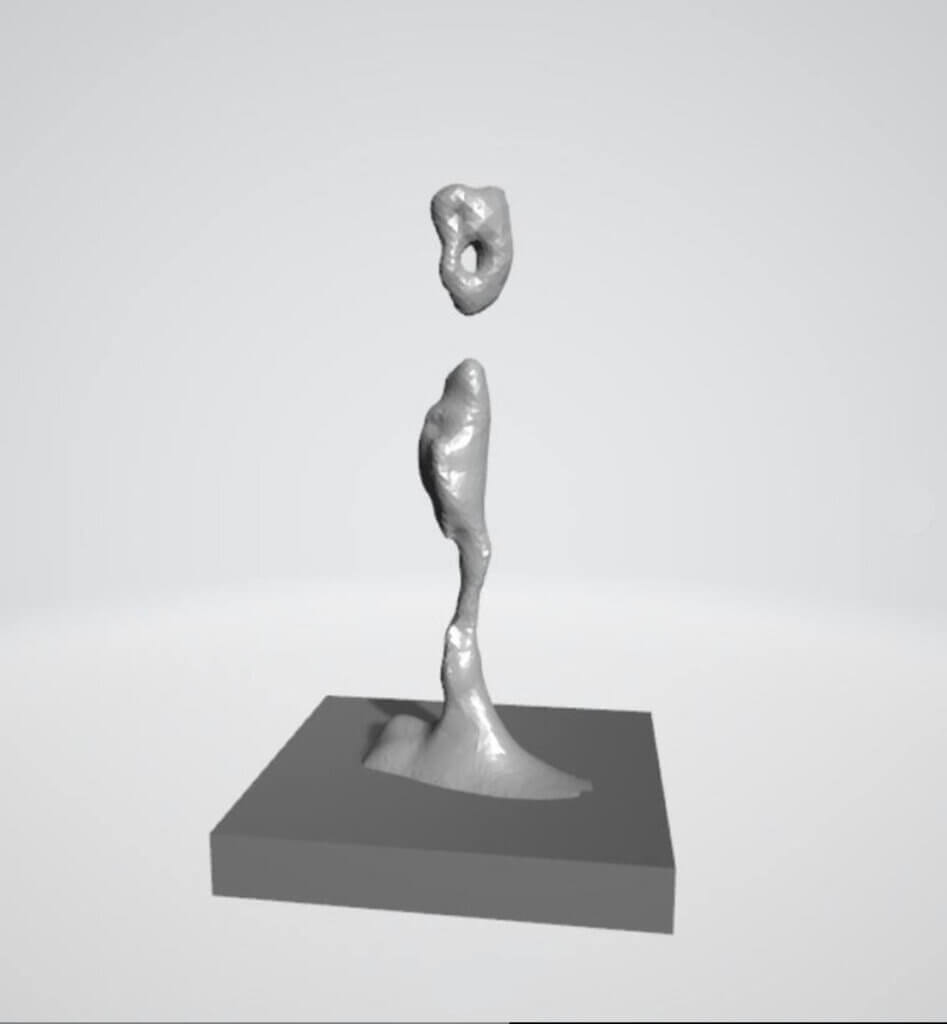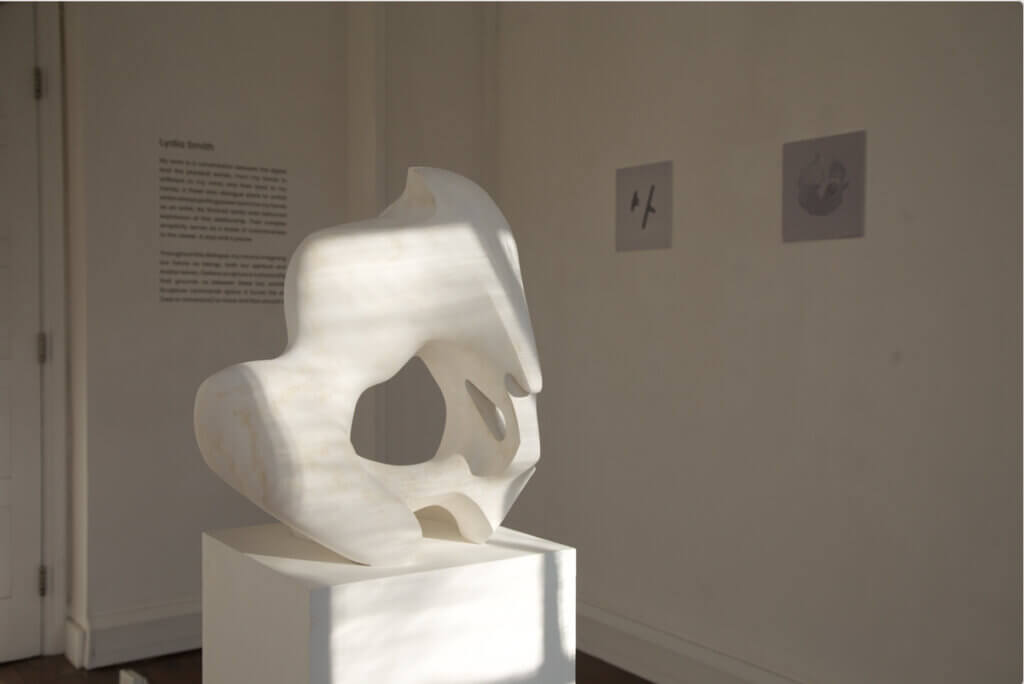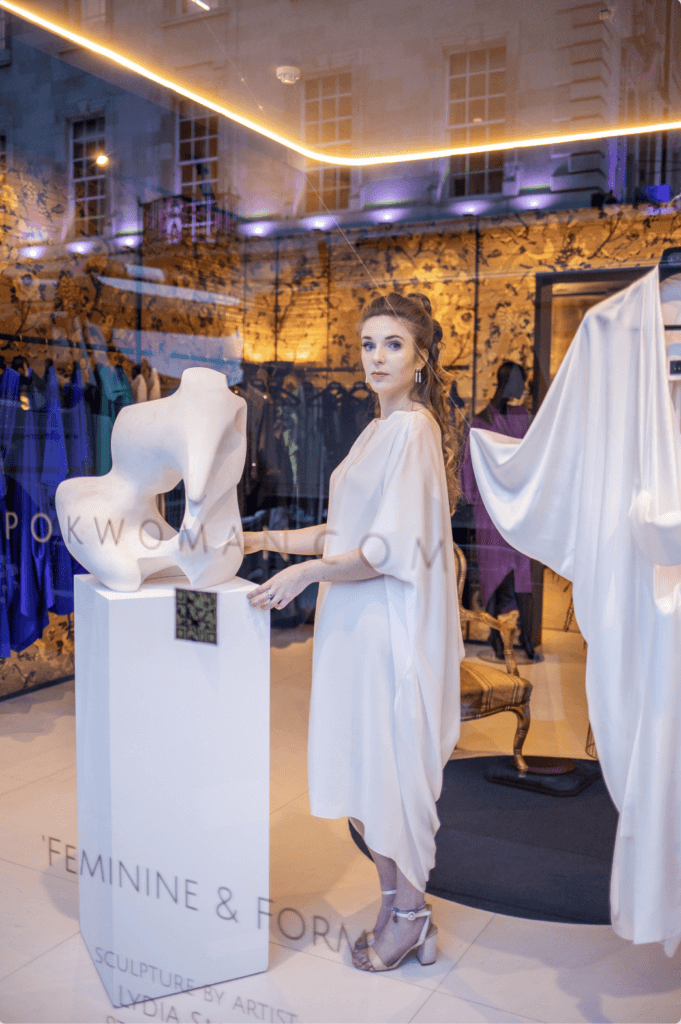Lydia Smith is a London based Sculptor whose work explores the intersection of the physical and digital world—informed by a curiosity to understand the world around her and the desire for continuous (and collaborative) conversation between her hands, software, and mind.
I will always be doing something creative. I can’t imagine my life without art. Everything I have ever done, every decision I have made, has been for my art.
Lydia Smith
Smith integrates an Xbox Sensor into her artistic practice, sculpting from the data image with an emphasis on maintaining the balance between two worlds and placing the power back into the hands of the artist. A process she first thought to be a failure inspired a new direction for the artist. The results are expressively unique, smoothly contoured sculptures that appear to have stop time when observed.
Smith’s voyage into the art of sculpture has been a tremendous journey starting at the University of the Arts London in 2014 and continuing her training at private ateliers in Greece, Spain and France and a career in the Film industry as a modeller and carver working on Box-office hits such as Tomb Raider, Game of Thrones, Dr Dolittle, Star Wars, The Eternals, Dr Strange and Ant-Man 3.
Currently, Smith is working with E P O K woman, a clothing brand in Mayfair and preparing to release her first NFT in collaboration with the Brand. If Smith’s hands could talk, the stories would be 5 part docu-series. However, we managed to catch up with the London based sculptor to hear it first-hand.
Q: Lydia can you please introduce yourself for those who do not know you?
Lydia Smith: Hi, I’m Lydia Smith. I’m a sculptor. I’m 27 and from Amersham in Buckinghamshire. I work with clay, polystyrene, ice and snow, bronze and marble.
Q:Can you tell us how you got started in arts and why you decided to become and artist?
Lydia Smith: I was always into art as a kid, classic! But it was the only thing I was good at at school, and I had a supportive art teacher called Mrs Nicols. I was drawing a tomato just in colour pencil, and I started to put blue tones in the skin of the tomato, and she came over and asked me, “why I was putting blue in my tomato?” as everyone else was doing red. I said as “I could see blue tones in the tomato”, and “she said very good”. That’s when I realised maybe I’m kind of good at this. So I continued doing it all the way into A level, and she was really supportive. Then I went to UAL’s Camberwell, Chelsea and Wimbledon Art Foundation, where I thought I was going to do illustration, as I had illustrated a children’s book as part of my A-Levels.
But I really got into creating things in 3D and always had done it at school, but we didn’t have the facilities, we didn’t have a kiln; I went to a state school we didn’t have much. So when I started experimenting in all the different pathways like fashion and painting. I remember being in painting class; our task was to go out and photograph colourful window displays, bring them back to class, and choose one to paint.
I wasn’t very rebellious at school. I was a goody-two-shoes; however, I got irritated by this and thought this is really stupid and boring to me, and I ended up folding up the pictures into fans and glueing them together with tape as a kind of defiance. The tutor came over and said to everyone this is what you should be doing.
I was like, I don’t understand art. I started sculpting characters and people. I wanted to do illustration, but they told me I couldn’t sculpt my people, I had to draw them, so I was stuck. That’s when I discovered technical art and special effects at Wimbledon College of Art. So I did that course, where I learned how to do figurative sculpting, mould making, puppet making, prop making, green screen, and a little prosthetics.
I specialised in figurative sculpting and completely fell in love with it, as I had been learning how to do figurative sculpting when I was 16. I used to work as a lifeguard and in a pharmacy all weekend while I was at school to pay for my sculpting lessons in school holidays.
I took my skill from there and incorporated them at uni; for my final piece, I did a life-size statue of myself, which was in reference to a poem my Grandfather had written to me in my 20th Birthday card. He died the year before that piece was made. So that was a real emotional integral piece. That piece got a few people interested in the film industry in my work.
I did a lot of work experience when I was at Uni, Pinewood Creative and some other prop companies and just took on everything I possibly could and just said yes to everything and got a job straight out of uni at Pinewood Creative. I was doing woodwork, fiberglassing a little bit of sculpting. The team was nice, but I knew I would get stuck if I didn’t leave as I wanted to do sculpture.
I got my portfolio together on tea breaks and lunch breaks. I would sneak out of the workshop on-site at Pinewood and wait outside different art departments, as you have to have a special pass to get in, which I didn’t have. When someone came out of the door, I just snuck in. Then I would knock on the guy’s door, as he looked important, which was the art director. I had no idea of politics, ladders, or all these things. Probably the most important door I could have knocked on. I just knocked; he said, “come in” I was like, “I’m Lydia Smith. Can I have 5 mins of your time? I’m a sculptor”, and he said yes. Then I showed him my work, and he was impressed.
He set up meetings with all the other art directors on-site at the time. After a couple of months of doing things like that and making friends with security guards. Who gave me the code names of the other films at other studios. I got a random email, saying hey Lydia, “I have some sculpting work for you on Tomb Raider”. I was like, cool, “I’ll be there”, with no idea what I was doing. I had never done it before, I just turned up with my clay kit, and we were doing architectural reliefs in clay and polystyrene rock sets.
Then I met more people and worked in the movies for four and a half years. From Tomb Raider, I then did Game of Thrones, Dr Dolittle, Star Wars, The Eternals and Dr Strange. I’ve exclusively been working with Disney and Marvel for the last two years in construction. I love the job; the main thing is I’ve met great people and great sculptors. But I’ve always wanted to be an artist; alongside doing the job, I was doing my work on the side, figurative sculpture honing my skill. When lockdown hit, I did a sculpture called Self Talk. It was a portrait of me with a little person in the head whispering in the ear.
It was about the positive or negative self-talk that we tell ourselves. You should try to listen to the good voice instead of the bad voice. After I finished it, I looked at it like, I don’t know what else I can get from this, in terms of figurative sculpting. I think I’ve exhausted it. I’ve been doing it for the last four years, and what do I do now. I still lived at home with my family and had a little studio in the back garden. I was grateful for; that’s when I decided to move to London during the pandemic and shared a studio with two friends. But I was still commuting and driving 3 hours out of London to the film industry, which was my full-time job, but it just wasn’t working. So I thought I had to throw all of my eggs into the basket and commit to doing it.
So I finished up on Ant-Man 3, left my shared studio, sublet my house, packed up my things into my Fiat 500, and drove around Europe, going from art residency to art residency for three months on my own. That’s where I have discovered this body of work that I’m currently making and my voice within art combining everything I’m interested in, architecture, ancient history, archaeology, conspiracy theories, science, black holes, nature versus artificial, spirituality and technology, gaming. All the things I’ve been obsessed with in my personal life since I can remember all hit me in a wave when I took this time out for myself.
Q: You mentioned you competed in international ice sculpting competitions. Can you tell us some more about this?
Lydia Smith: While at university, I entered a competition to be part of the British Snow and Ice Carving team, and I got picked. I went out to Switzerland 3 years in a row to sculpt internationally out of snow and came 2nd and 3rd each year.
I made friends with the other teams, there was a Ukrainian team I became friends with them, and they invited me to join their team. So I competed as part of both the British and the Ukrainian team. in China. I spent three weeks at the International Snow and Ice championships. There you had to do two ice sculptures. One was assemblage, where you got given snow and ice blocks, you could only cut them into square shapes to assemble your design, and you had to stick them together with water.
There was me representing Britain and three Ukrainian men on our team; it was freezing -24. It wasn’t delightful. You got your chainsaw out and cut the ice, then glued it together with water. We had to do the first one in three days, and it was so physically exhausting. Then you go into the next one where you have a solid block of ice, 2m by 3m by 1m and had to carve a design out of it. We were split into two’s, me and Alexi did an ice sculpture of a bear with a butterfly on his nose, resting on a coin with the Ukrainian map carved on one side of the coin and the British on the other. It was amazing. I loved it.
Then we went straight into again, no rest day between the competitions, the snow carving competition. Which was a 3m by 3m by 3m square of snow; using chainsaws and long pieces of wire, we did a face coming out of the plinth with rolling balls of yarn for its hair, and we came forth.
Q: Your practice focuses on discovering objects from the imperfections of digital processing. Can you tell us some more about your practice, inspiration and the direction in which your work is going?
Lydia Smith: Anything to do with sculpture, let me make it. It doesn’t matter the material; this is why now I’m broaching into the digital space as well as the physical space.
I never thought I’d do that. I’d say, “I’m never touching the digital stuff”, even a year ago. I would say I don’t like it, but I have completely gone back on what I said; I’m a hypocrite. But in the process, I will always work with clay first. It’s a natural material that feels good in my hands. When I’m creating in clay, the process feels meditative and calming, and time stops.
When I’m in my studio, and it’s just me and the clay and me and the sculpture having a conversation, I don’t care what’s going on outside. I’ve chosen to spend my days in this box with a lump of mud, and it makes me happy to see what comes out of it. I like using Xbox One sensor because it doesn’t capture the object accurately. The technology has its own interpretation of my artwork. When I first tried the experiment, I thought it was a failure because it did not accurately represent the object. Then I thought, no, this is the magic of it. Is the computer curating it intelligently and showing me something it wants to show me, or is it glitches? We don’t know the answer to that question.
Then I thought, I’m the human being; I’m an artist. How can I take what technology has given me as a tool and use my artistic interpretation to bring it back into the physical world. The relationship changes depending on how I interpret the object. I’ll play with the digital render on a 3D rotation and sculpt while watching the video that creates a sculpture in the round as a mini miket. After a few days, I’ll come back to it and dive in and do a bigger version. That creates the original physical world being in communication with the digital. Yet putting the power back into my hands as the artist and into the consciousness of the human being to curate decisions.
As I believe in society at the moment, we hold tech too accountable to fix all of our problems when it is just a tool, and it helps us with many things and makes our lives easier in numerous ways. But you have to monitor yourself and don’t hold too many expectations of it to fix your problems. I think it’s crucial for me always to be the final person in charge when working with clay. The digital work I create from these scans I edit digitally by digitally sculpting them. Then I collaborate with other artists to wrap their paintings or imagery around my digital sculpture.
It then creates a co-authored piece of artwork in the digital space. I apply different finishes to them, and these sculptures are NFT artworks as part of the package. These can be MP4 rotations you can play on the screen, which you can put into the metaverse such as Decentraland or an office or public park; that’s what I envisage these sculptures to do.
You can also project these in holographic technology, bringing these digital works into the physical world. However, I love the idea you can put your hand through it as it’s not a sculpture as sculpture has weight. Sculptures take up space. You have created a 3D thing which moves the space around it; what I find interesting about hologram sculptures is that they are empty; they don’t really exist; they’re just light. I find this fascinating in terms of is it a sculpture if it’s a hologram.
The digital NFT works go hand in hand with the topic of tech vs nature and how we have to balance them both. Leads me to my illustration of a character I’ve created is my interpretation of the human race at the current moment. A space robot with a VR headset for a head and a Sims 3 triangle for a brain. As if we are all stuck in a simulation. We have to be conscious of our relationship with technology and our relationship with society, each other, the planet, and ourselves.
This series of illustrations is called a series of selves, and I look at social media and body image topics, pharmaceutical companies, and eastern medicine. Uploading ourselves into the metaverse, but also practising meditation. How can we balance the yin and yangs of our modern-day culture within these topics? As we can’t live without technology now as we created it. But we have forgotten some of our ancient histories, which are very connected to our bodies and minds and how to connect in an era where the individual has more integrity than the tribe. Where we potentially don’t trust each other anymore and feel safer to be on our own potential because we are afraid of what else is out there. So that’s what my theory of selves is about.
Q: Your currently working in partneship with E P O K woman, a female fashion brand with a flagship store in Mayfair. Can tell us some more about this collboration?
Lydia Smith: I came back from travelling. I was fortunate enough to go straight into an art residency in Soho at 13 Soho square for six weeks. I had four weeks of making time and then two weeks of the exhibition. This is where “Be more like a horse”, “Leftovers always taste better the next day”, and “Inside the horizon” were on display, alongside some of my digital work. That went well and was my first solo show and the first time showing my new work.
That led to a collaboration with E P O K woman, a female fashion brand with a flagship store in Mayfair. We did an exhibition for two months, which launched on international women’s day. My sculpture and their clothing compliment each other in the way Prudence, the designer. She drapes her silk fabrics over the models using one material and sculpting the form around the form. It reflected the movement I made when I scanned my sculptures with the Xbox one sensor going all the way around. We are now going into another exhibition where we will be launching an NFT at the event, which is also part of WAAW, Women artist art week. From the 8th to the 15th of June, you may see me at other places within that week.
I’m excited it’s the 1st time my new sculpture Foreign Body, will display in the flagship store in Mayfair. The launch of the NFT, which is a collaboration between the brand and me, has to do with digital antiquity. No one has seen that. It’s a reflection of antiquity and the metaverse. All are being presented alongside WAAW.
Q: They say the studio is the sacred temple of creativity. What are the three things you cannot live without in your studio?
Lydia Smith: Clay, number one! My studio can be anywhere as long as I have a bag of clay, which I learned when I was away. I was making moulds with materials I wouldn’t use here, like straw and different types of plaster and using different kinds of clay. As long as I have a bag of clay and armature wire, I can make a sculpture anywhere.
My favourite sculpting tools have a serrated edge. So you get nice textures with them. I let my clay dry quite hard before I sculpt it. To me, it’s easier if the sculpture cracks because the clay is too hard. You can wrap it up and take care of it, then inlay more clay.
Whereas if it is too wet, it’s tough for you to get defined angles and lines and also clay itself can support itself. Even though the armature wire is essential, I will always have armature wire sticking out of my sculpture without fail.
As I don’t plan my armature around my sculpture when I’m doing it for my work, I find it restrictive. If I measure out an armature completely right, I’ve already designed the sculpture to me, I’m not able to have a relationship with the work as it’s forming.
So it used to annoy me that I’d have armature bits sticking out, but you can edit that in the moulding and casting process. It’s more important to me that I have the flexibility to move and change a sculpture while I’m in conversation with it. My tools are really important. I use a kitchen knife. Just a butter knife, it’s one of my favourites. A friend gave it to me; he was like, I use this. It’s really good. It’s one of my primary tools.
Q: What’s next for you as an artist ?
Lydia Smith: I’m continuing to explore digital works. I think I will scan a pinecone and see how technology picks that up. There is a gland in our brain that is the shape of a pinecone, and apparently, it has electromagnetic energy. It’s a big whole of research; that’s my practice. I do paintings as well; that’s a new thing. I take the concept of my sculptures and do graphic thick black oil paintings—another avenue of exploring what I’m thinking when I’m creating a sculpture.
The collaborations that I already mentioned. I want to see “Be More Like a Horse” and “Foreign Body” as large scale public artworks. I also want to work with a gallery. I don’t currently have gallery representation; I’d like to explore that relationship. Potential public sculptures in the east somewhere, going through planning. Just being in my studio and seeing other artists that’s something I love. I have recently met so many great artists who are friends and have become good friends. Like Maitha Abdallal, currently the resident at “An Effort” in Soho, the residency I did.
James Rodger is an incredible artist who also uses an Xbox scanner and initially showed me the technology. Luap, Benjamin Spires. Being in the studio can be lonely. I live with other people, which is nice. It’s nice to talk to other artists who understand the trials and tribulations and celebrate the good times. Being an artist is such a weird job. No one understands it unless you are in the art industry., The unknown and the magic of the unknown. Fight or flight, and I’m always in fight.
Q: Lastly, what does art mean to you?
Lydia Smith: Art is my life; it’s the thing that wakes me up in the morning. It’s the thing I can’t get enough of. It’s the thing that challenges me when I hate something. When I love something, it always has me questioning why I’m doing things and why others are doing things. It also allows me to research the big questions in life and talk about them through sculpture or illustration. I will always be doing something creative. I can’t imagine my life without art. Everything I have ever done, every decision I have made, has been for my art.
To learn more about emerging artist Lydia Smith’s work, head over to her Instagram and website link below.
©2022 Lydia Smith


